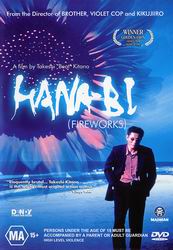Hana-bi (Fireworks/Takeshi Kitano-Volume 7) (1997) |
|
Hana-bi (Fireworks/Takeshi Kitano-Volume 7) (1997) |
|


|
| BUY IT |
| General | Extras | ||
| Category | Drama |
Theatrical Trailer Featurette Trailer-Spirited Away;Swing;Satin Rouge;Ring;Rain;Monsoon Wedding |
|
| Rating |

|
||
| Year Of Production | 1997 | ||
| Running Time | 98:42 (Case: 103) | ||
| RSDL / Flipper | RSDL (71:02) | Cast & Crew | |
| Start Up | Menu | ||
| Region Coding | 1,2,3,4,5,6 | Directed By | Takeshi Kitano |
|
Studio
Distributor |
 Madman Entertainment |
Starring |
Takeshi Kitano Kayoko Kishimoto Ren Osugi Susumu Terajima |
| Case | Amaray-Transparent-Secure Clip | ||
| RPI | $28.95 | Music | Joe Hisaishi |
| Video | Audio | ||
| Pan & Scan/Full Frame | None | Japanese Dolby Digital 2.0 (192Kb/s) | |
| Widescreen Aspect Ratio | 1.78:1 | ||
| 16x9 Enhancement |
 |
||
| Video Format | 576i (PAL) | ||
| Original Aspect Ratio | 1.85:1 | Miscellaneous | |
| Jacket Pictures | No | ||
| Subtitles | English | Smoking | Yes |
| Annoying Product Placement | No | ||
| Action In or After Credits | No | ||
†††† I have seen this flim so many times it is etched into my memory. It is by far one of my all time favourite films. Brilliant, hilarious, depressing, violent, passionate, dispassionate, silly, heartbreaking -- this film thrives on its inability to be neatly classified, cross-referenced and easily catalogued.
†††† Takeshi Kitano, who goes by the screen name of ĎBeatí Takeshi, plays a hard edged Tokyo cop named Nishi who is up to his eyeballs in debt to the Yakuza (Japanese Mafia) and keen to spend some time with his terminally ill wife Miyuki (Kayoko Kishimoto). At the same time he is trying to make up for the mistakes he made during his final days as a cop: giving his former partner, Horibe (Ren Osugi), a renewed will to live by teaching him a love of art, and paying reparations to the families and loved ones of those who died because of his errors.
†††† This is extraordinary filmmaking. Told in eerie flashbacks around a linear narrative, a coherent picture finally forms towards the midpoint, heading towards a climax that will leave you both renewed with a sense of hope as well as shocked and in tears. Moreover, it works on a strange principle of counterpoint, with savage and graphic violence pitted against cute and often silly humour in a fashion that works just so well. All of this is complemented by a wonderful score by Joe Hisaishi that stays in your head long after the final scene. And Takeshi pulls all this off with maybe a dozen lines for the entire film. The deadpan style is just masterful. Given the fact that he also wrote and directed this film, the phrase Ďcontemporary geniusí certainly springs to mind.
†††† I cannot recommend this film highly enough. Unquestionably a masterpiece.
†††† This transfer is not perfect, but it is so far above the quality of the R1 release that it does stand out.
†††† The R1 release of this film has hands down one of the poorest transfers it has been my displeasure to witness. Letterboxed in 1.85:1 (the original aspect ratio), the R1 DVD has some of the worst MPEG artefacts Iíve ever encountered, most notably MPEG blocking and this odd digital ghosting, appalling shadow detail, shocking low-level noise Ö the list just goes on. For a dual-layered disc, that was a botching of the highest order.
†††† The R4 release, thankfully, has been remastered with a 16x9 enhancement, which makes a huge difference. Although the print is now framed at 1.78:1, there is only minimal difference from the 1.85:1 original ratio.
†††† Overall, the print is fairly dark, which was an intentional technique on behalf of the director as far as I can tell. This is meant to be film noir, and there is only very minimal artificial lighting used. As a consequence, shadow detail is pretty minimal, but black is a deep saturated black, not a cloudy and messy grey.
†††† There was next to no low-level noise, and only a few flecks of dirt on the print that I could see. Colours were well saturated, which is important, particularly when the shots are composed of still shots of Horibeís artwork (which was in fact painted by Kitano himself during his recuperative period after a near fatal motorcycle accident).
†††† Unfortunately, the picture is not perfect, exhibiting an odd jerkiness in some panning shots, as well as a strange wobble on hard edges during shots which are held for some time. These do not appear to be any of the standard MPEG artefacts, and may be a problem with the source. This was generally not a problem except for one shot at 67:23 where Horibe is looking at the Japanese flower blossoms. This shot disintegrates into a digital mess as the wind blows the branches.
†††† There was also some light aliasing, most notably on Nishiís blacker than black sunglasses. On the whole, this was not terribly distracting.
†††† The dual-layer pause is at 71:02. It happens during a scene change and is a little jarring as it is a cut to a stone skipping across a pond. At least it is not in the middle of a line of dialogue.
| Sharpness | |
| Shadow Detail | |
| Colour | |
| Grain/Pixelization | |
| Film-To-Video Artefacts | |
| Film Artefacts | |
| Overall |
†††† Where the R1 release made up for its shortcoming in its video transfer was the remixed Japanese 5.1 Dolby Digital Surround Sound track. This track is awesome, with a full surround field, particularly when the music comes in, and good bass usage during the various violent outbursts which add just that much more impact to them. It is also the original mix, as there is a reference in the end of the credits to Dolby Digital Surround Sound, one of the only things I could really make out in the Japanese writing as it uses the original English copyrighted logo.
†††† The Japanese 2.0 Dolby Digital Stereo replacement on the R4 release just doesnít come close to equating its R1 counterpart. However, it does deserve analysis on its own merit.
†††† There were some very good left-right directional cues on this track, but nothing in the way of a surround presence. When I used my amplifier to remix the track into a 2.0 Surround Sound field, there was some surround information present, particularly when the score dominates the track. But it was nominal, and the thinning of the field didnít sound quite right. The bass dropped out and the treble was a little tinny. In its plain 2.0 Stereo mix, the bass was well utilised to intensify the impact of fists against skulls and knees with groins, but it has nothing on the subwoofer use on the R1 release.
†††† The accompanying subtitles appear to be fairly accurate, being a copy of the Ďenhanced subtitlesí provided on the R1 release. I found no discernible difference in them.
†††† There was no subwoofer use, which is a pity because it does make a difference.
| Dialogue | |
| Audio Sync | |
| Clicks/Pops/Dropouts | |
| Surround Channel Use | |
| Subwoofer | |
| Overall |
†††† All menus are 16x9 enhanced and silent.
†††† Presented in 1.85:1, non-16x9 enhanced, 2.0 Dolby Digital Stereo, the audio has a constant hum as well as lots of pops and clicks.
†††† Presented in 1.33:1, non-16x9 enhanced, and with 2.0 Dolby Digital Stereo audio, this documentary opens with the trailers of Kitanoís earlier films, most notably the cult classic Violent Cop and the intensely and sadistically violent Sonatine. After the preamble, this featurette melds into a regular documentary regarding the making of Hana-Bi. This includes interviews with Kitano and several on set snippets. The quality of this documentary is pretty bad, prone to MPEG blocking and shot through with low-level noise, but it is still watchable.
†††† Presented in 1.85:1, non-16x9 enhanced, 2.0 Dolby Digital Stereo.
†††† Presented in 1.85:1, non-16x9 enhanced, 2.0 Dolby Digital Stereo.
†††† Presented in 1.85:1, non-16x9 enhanced, 2.0 Dolby Digital Stereo.
†††† Presented in 1.85:1, non-16x9 enhanced, 2.0 Dolby Digital Stereo.
†††† Presented in 1.85:1, non-16x9 enhanced, 2.0 Dolby Digital Stereo.
†††† Presented in 1.85:1, non-16x9 enhanced, 2.0 Dolby Digital Stereo.
NOTE: To view non-R4 releases, your equipment needs to be multi-zone compatible and usually also NTSC compatible.
††† The R1 release misses out on:
††† Given the fact that the R4 release is actually watchable without causing serious ocular damage, Iím going to give this one to the R4 release. This was a tight chase, though, because the soundtrack is definitely better on the R1 release, and I can only hope the studio will one day release a fully remastered disc. For the moment, though, the R4 is the better choice.
††† Hana-Bi is one of the best films Iíve ever seen. An emotional rollercoaster, to be sure, but youíll be hard-pressed to get this out of your head for the next few weeks -- that's a guarantee. And thereís so much to this film, youíll watch it again and again.
††††The picture quality is an improvement on the R1 release, but pretty much anything would have been an improvement on the R1 video which is just so shockingly awful I donít have the words to describe it (actually, I do, but Iím not going to publish them here).
†††† The Japanese 2.0 Dolby Digital track doesnít have a bar on the R1 5.1 Dolby Digital release, so Iím a little disappointed. This track is okay, but so totally stock standard it is a bit of a letdown.
†††† The extras are quite good, and I liked the fact that the retrospective introduction to the documentary was not removed from the featurette.
| Video | |
| Audio | |
| Extras | |
| Plot | |
| Overall |
| Review Equipment | |
| DVD | Panasonic DVD-RV31A-S, using S-Video output |
| Display | Beko 28" (16x9). This display device is 16x9 capable. |
| Audio Decoder | Built in to amplifier/receiver. |
| Amplification | Marantz SR7000 |
| Speakers | Energy - Front, Rear, Centre & Subwoofer |